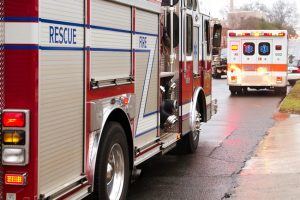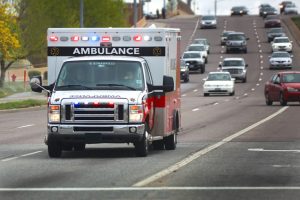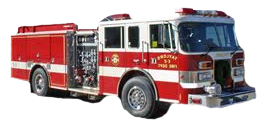Emergency Vehicles: Slow Down and Move Over
 Many drivers freeze or panic and are uncertain about what actions to follow when they see emergency lights and continue driving like normal. A South Carolina law implemented in 2002 requires drivers to move to the non-adjacent lane when passing emergency vehicles (police, firefighters, paramedics, tow truck drivers) that are stopped on the roadside with emergency lights flashing, or slow down if moving over is not an option. Many don’t know that this law exists and that they may receive a ticket with a fine and the possibility of points being added to their driving record. In South Carolina, this violation is a misdemeanor offence and the state law requires a fine of $300 to $500.
Many drivers freeze or panic and are uncertain about what actions to follow when they see emergency lights and continue driving like normal. A South Carolina law implemented in 2002 requires drivers to move to the non-adjacent lane when passing emergency vehicles (police, firefighters, paramedics, tow truck drivers) that are stopped on the roadside with emergency lights flashing, or slow down if moving over is not an option. Many don’t know that this law exists and that they may receive a ticket with a fine and the possibility of points being added to their driving record. In South Carolina, this violation is a misdemeanor offence and the state law requires a fine of $300 to $500.
Approaching an Emergency Scene
Drivers are required to keep their vehicle under control, proceed with due caution, reduce vehicle speed, make a lane change into the non-adjacent lane, and if that is not an option, maintain a safe speed for the road conditions. An authorized emergency vehicle includes: ambulance, police vehicle, fire vehicle, rescue vehicle, recovery vehicle, and towing vehicle. The law states that any “paid or volunteer worker at an emergency scene has proper authority to be at and control the scene in a manner consistent with his training.” Obeying this law can prevent injury and save a life.
Sharing the Road with Emergency Vehicles
From the SC Driver’s Manual 2019
Emergency vehicle drivers must drive with regard for the safety of other highway users. Under emergency conditions drivers may violate certain rules of the road such as driving faster than the posted speed limit, going through a red light or stop sign after slowing down, parking in places where it is usually prohibited, and disregarding rules covering direction of movement or turning.
Some emergency vehicles have sirens and flashing red lights or a combination of flashing red and blue lights. These lights help the emergency vehicles move quickly through traffic to assist emergency calls. The different types of emergency vehicles include ambulances, fire department and police cars.
As a driver when you hear a siren or an emergency vehicle approaching you should pull over to the curb or the edge of a road and stop. For one-way streets drive parallel to the road edge closest to you. Avoid intersections when possible. After the emergency vehicle passes, check the traffic around you before you return to the roadway. You must keep a safe distance between your vehicle and the emergency vehicle. During an emergency situation you must obey any uniformed officer.
“Move Over” Law or “Emergency Scenes” Law in SC
Move-over laws are specifically designed with the safety of emergency personnel in mind. In 2002, a South Carolina law was implemented that requires all drivers to move over to the non-adjacent lane when passing emergency vehicles that are stopped on the side of the road with emergency lights on, or slow down if moving over is not an option. Many states have made this requirement and titled them as “move-over” laws.
The move-over law is established under South Carolina Code § 56-5-1538 and states that an emergency scene is a “location designated by the potential need to provide emergency medical care and is identified by emergency vehicles with flashing lights, rescue equipment, or emergency personnel on the scene.” The law also states that all motor vehicles are required to not interfere with duties of emergency personnel when passing through designated emergency scenes.
 South Carolina Code Section 56-5-1538. Emergency scene management; definitions
South Carolina Code Section 56-5-1538. Emergency scene management; definitions
(A) An emergency scene is a location designated by the potential need to provide emergency medical care and is identified by emergency vehicles with flashing lights, rescue equipment, or emergency personnel on the scene.
(B) An emergency scene is a special hazard.
(C) An emergency scene is under the authority of the first arriving emergency personnel, which includes emergency medical services personnel, until the arrival of the fire or law enforcement officials having jurisdiction. All motor vehicles passing through an emergency scene and pedestrians observing an emergency scene must obey and not interfere with the duties of emergency personnel. Motor vehicles and bystanders may not block access to or exit from an emergency scene.
(D) The management authority of emergency medical services is limited to managing patient care and preventing further injury to the patients and on-scene personnel. This authority may be delegated by emergency personnel to provide an adequate level of safety.
(E) A paid or volunteer worker at an emergency scene has proper authority to be at and control the scene in a manner consistent with his training.
(F) The driver of a vehicle shall ensure that the vehicle is kept under control when approaching or passing an emergency scene or authorized emergency vehicle stopped on or near the right-of-way of a street or highway with emergency lights flashing. The exercise of control required for a driver to comply with this section is that control possible and necessary by the driver to prevent a collision, to prevent injury to persons or property, and to avoid interference with the performance of emergency duties by emergency personnel.
(G) A person driving a vehicle approaching a stationary authorized emergency vehicle that is giving a signal by displaying alternately flashing red, red and white, blue, or red and blue lights, or amber or yellow warning lights shall proceed with due caution, significantly reduce the speed of the vehicle, and:
(1) yield the right-of-way by making a lane change into a lane not adjacent to that of the authorized emergency vehicle, if possible with due regard to safety and traffic conditions, if on a highway having at least four lanes with not less than two lanes proceeding in the same direction as the approaching vehicle; or
(2) maintain a safe speed for road conditions, if changing lanes is impossible or unsafe.
(H) A person who violates the provisions of this section is guilty of the misdemeanor of endangering emergency services personnel and, upon conviction, must be fined not less than three hundred dollars nor more than five hundred dollars.
(I) For purposes of this section:
(1) “Authorized emergency vehicle” means any ambulance, police, fire, rescue, recovery, or towing vehicle authorized by this State, county, or municipality to respond to a traffic incident.
(2) “Emergency services personnel” means fire, police, or emergency medical services personnel (EMS) responding to an emergency incident.
Resources:
https://www.thestate.com/news/local/crime/article182514596.html
https://www.scstatehouse.gov/code/t56c005.php
https://driving-tests.org/wp-content/uploads/2014/10/SC_3.pdf




